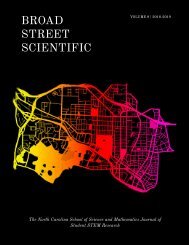Broad Street Scientific Journal 2020
Create successful ePaper yourself
Turn your PDF publications into a flip-book with our unique Google optimized e-Paper software.
by touching the worms’ heads; paralysis was scored if the
worm did not move or only moved the head.
3. Results/Discussion
3.1 – Molecular Docking Studies
Molegro is a computational platform for predicting
protein-ligand interactions. In Molegro, the protein
2MXU was taken from the Protein Data Bank as a model
of Aβ fibril aggregation. 2MXU shows a fibril structure
composed of multiple peptide monomers. Two different
approaches were taken with this protein. One was of a
smaller fibril structure and the other of a dimer with a cavity
located between. Because the mechanism behind how
drugs like tetracycline work to dissolve the preformed fibril
is not currently known, both approaches were used.
With the fibril structure approach, the ligand bonds to the
outside of the fibril protein in a smaller cavity. With the
dimer structure approach, the ligand binds between the
two monomers (Fig. 2).
binding when more negative. Through using Molegro to
model the interactions between protein and ligand, it was
possible to find that in both the fibril and dimer formation,
CMTs repeatedly and consistently outperform tetracycline
and its natural analogs (Tab. 1).
Table 1. Molegro data table of binding affinities,
where more negative values are more effective, for
tetracycline and analogs with both the fibril (top)
and dimer (bottom) approaches.
Molecule Fibril binding affinity (avg.)
Tetracycline -9.69
Doxycycline -10.10
Minocycline -8.28
CMT-3 -14.43
CMT-1 -13.45
Molecule Dimer binding affinity (avg.)
Tetracycline -11.00
Doxycycline -12.33
Minocycline -9.37
CMT-3 -17.17
Among the CMTs themselves, however, there were
varied results. By testing different CMTs, it was possible
to find the more effective Aβ aggregation inhibitor to use
in further treatment. CMTs-1, 3, 4, 5, 6, 7, and 8 were all
used (Fig. 3). Because the same trend was seen in both the
fibril and dimer approach, with CMTs outperforming tetracycline
and its natural analogs, the calculated binding
affinities were only compared for the fibril approach. The
compounds with the most effective binding affinities were
shown to be CMT-3, CMT-4, CMT-5, and CMT-7 (Tab.
2).
Figure 2. Molegro screencap of Aβ fibril protein
2MXU with tetracycline (green) integrated into both
fibril structures (top) and dimer structure (bottom).
When modeling the effectiveness of different ligands on
Aβ aggregation inhibition efficiency, tetracycline and its
analogs can be interpreted as effective through the analysis
of binding affinities. Binding affinities show more effective
Figure 3. Structures of CMTs (in order: 1, 3, 4, 5, 6, 7, 8).
42 | 2019-2020 | Broad Street Scientific CHEMISTRY




